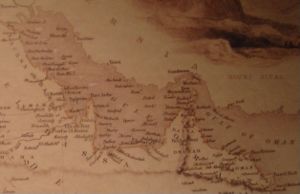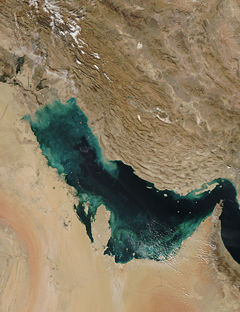Persian Gulf
2008/9 Schools Wikipedia Selection. Related subjects: Geography
| Persian Gulf | |
|---|---|
|
|
|
| Location | Southwest Asia |
| Ocean type | Gulf |
| Primary sources | Sea of Oman |
| Basin countries | Iran, Iraq, Kuwait, Saudi Arabia, Qatar, Bahrain, United Arab Emirates and Oman (exclave of Musandam) |
| Max length | 989 km |
| Max width | 56 km (min) |
| Surface area | 251,000km2 |
| Average depth | 50 m |
| Max depth | 90 m |
The Persian Gulf, in the Southwest Asian region, is an extension of the Indian Ocean located between Iran and the Arabian Peninsula. Historically and commonly known as the Persian Gulf, this body of water is sometimes controversially referred to as the Arabian Gulf by certain Arab countries or simply The Gulf, although neither term is recognized internationally.
The Persian Gulf was the focus of the Iraq-Iran War that lasted from 1980 to 1988, with each side attacking the other's oil tankers. In 1991, the Persian Gulf again was the background for what was called the Persian Gulf War or the " Gulf War" when Iraq invaded Kuwait and was subsequently pushed back, despite the fact that this conflict was primarily a land conflict.
The natural environment of the Persian Gulf is very rich with good fishing grounds, extensive coral reefs, and abundant pearl oysters, but its ecology has become increasingly under pressure from the heavy industrialisation and in particular the repeated major petroleum spillages associated with recent wars fought in the region.
Geography
This inland sea of some 251,000 km² is connected to the Gulf of Oman in the east by the Strait of Hormuz; and its western end is marked by the major river delta of the Shatt al-Arab, which carries the waters of the Euphrates and the Tigris. Its length is 989 kilometres, separating mainly Iran from Saudi Arabia with the shortest divide of about 56 kilometres in the Strait of Hormuz. The waters are overall very shallow and have a maximum depth of 90 metres and an average depth of 50 metres.
Countries with a coastline on the Persian Gulf are (clockwise, from the north): Iran, Oman (exclave of Musandam), United Arab Emirates, Saudi Arabia, Qatar on a peninsula off the Saudi coast, Bahrain on an island, Kuwait and Iraq in the northwest. Various small islands lie within the Persian Gulf, some of which are subject to territorial disputes by the states of the region.
Oil and gas
The Persian Gulf and its coastal areas are the world's largest single source of crude oil and related industries dominate the region. Al-Safaniya, the world's largest offshore oilfield, is located in the Persian gulf. Large gas finds have also been made with Qatar and Iran sharing a giant field across the territorial median line (North Field in the Qatari sector; South Pars Field in the Iranian sector). Using this gas, Qatar has built up a substantial liquified natural gas (LNG) and petrochemical industry.
The oil-rich countries (excluding Iraq) that have a coastline on the Persian Gulf are referred to as the Persian Gulf States. Iraq's egress to the gulf is narrow and easily blockaded consisting of the marshy river delta of the Shatt al-Arab, which carries the waters of the Euphrates and the Tigris Rivers, where the left (East) bank is held by Iran.
Etymology
In 330 B.C, the Achaemenid dynasty established the first Persian Empire in Pars (Persis, or modern Fars) in the southwestern region of the Iranian plateau. Consequently in the Greek sources, the body of water that bordered this province came to be known as the Persian Gulf.
Considering the historical background of the name Persian Gulf, Sir Arnold Wilson mentions in a book, published in 1928 that:
| “ | No water channel has been so significant as Persian Gulf to the geologists, archaeologists, geographers, merchants, politicians, excursionists, and scholars whether in past or in present. This water channel which separates the Iran Plateau from the Arabia Plate, has enjoyed an Iranian Identity since at least 2200 years ago. | ” |
No written deed has remained since the era before the Persian Empire, but in the oral history and culture, the Iranians have called the southern waters: "Jam Sea", "Iran Sea", "Pars Sea".
During the years: 550 to 330 B.C. coinciding with sovereignty of the first Persian Empire on the Middle East area, especially the whole part of Persian Gulf and some parts of the Arabian Peninsula, the name of "Pars Sea" has been widely written in the compiled texts.
In the travel account of Pythagoras, several chapters are related to description of his travels accompanied by Darius the Great, to Susa and Persepolis, and the area is described. From among the writings of others in the same period, there is the inscription and engraving of Darius the great, installed at junction of waters of Arabian Gulf (Ahmar Sea = Red sea) and Nile river and Rome river (current Mediterranean) which belongs to the 5th century BC where, Darius, the king of Achaemenid Empire has named the Persian Gulf Water Channel: Pars Sea.
Naming dispute

Since the 1960s with the rise of Arab nationalism ( Pan-Arabism), starting with Gamal Abdel Nasser's Arab Republic of Egypt, some Arab countries, including the ones bordering the Persian Gulf, have adopted the term "Arabian Gulf" (in Arabic: الخلیج العربي al-khalīj al-ʿarabī) to refer to the waterway. This is controversial and not commonly used outside of the Arab world, nor is it recognized by the United Nations and other international organizations. The United Nations on many occasions has requested that only "Persian Gulf" be used as the official and standard geographical designation for the body of water. "Arabian Gulf" is also an ancient name for the Red Sea. Hecataeus (472 to 509 B.C.) can be stated where Persian Gulf and Arabian Gulf (Red Sea) have been clearly shown. Also a map has remained from Herodotus, the great Greek historian (425-484 B.C.) which introduces Red Sea as the Arabian Gulf.
In the world map of Diseark (285-347 B.C.) too, Persian Gulf and Arabian Gulf have been clearly distinct. At the same time, many maps and deeds prepared up to the 8th century by the historians such as Arrian Hecataeus, Herodotus, Hiparek, Claudius Batlamious, Krats Malous,…… and in the Islamic period, Khwārizmī, Abou Yousef Eshagh Kandi, Ibn Khordadbeh, Batani (Harrani), Mas'udi, Balkhi, Estakhri, Ibn Houghal, Aboureyhan Birouni and others, mention that there is a wide sea at south of Iran named “Pars Sea”, “Pars Gulf”, “Fars Sea”, “Fars Gulf”, “Bahre Fars”, “Sinus Persicus” and “Mare Persicum” and so on. In a book, named “Persilus Aryateria”, the Greek traveller of the 1st century A.D. has called the Red Sea as Arabian gulf; the Indian ocean has been named Aryateria Sea; the waters at Oman Coast is called Pars Sea; Barbarus region (between Oman and Yemen coast are called belonging to Pars, and the Gulf located at south side of Iran is named: Persian Gulf. By describing the water body, the life of Persians living at both sides have also been confirmed.
Most recently, at the Twenty-third session of the United Nations in March-April 2006, the name "Persian Gulf" was confirmed again as the legitimate and official term to be used by members of the United Nations.
History
Colonial era
From 1763 until 1971, the British Empire maintained varying degrees of political control over some Persian Gulf states, including the United Arab Emirates (originally called the "Trucial Coast States") and at various times Bahrain, Kuwait, Oman, and Qatar through the British Residency of the Persian Gulf.
The United Kingdom maintains a high profile in the region; in 2006, over 1 million Britons visited Dubai alone.
Wildlife
Mangroves in the Persian Gulf, which are thought to require tidal flow and a combination of fresh and salt water, are nurseries for crabs, small fish and insects - and the birds that eat them.

